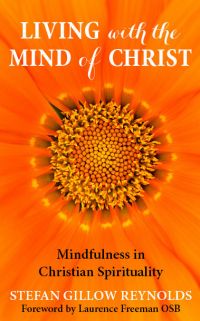Why Practising Christian Mindfulness Doesn't Mean Turning Buddhist

There is a tradition of mindfulness within Christianity, which I have tried to show in my recent book, 'Living with the Mind of Christ: Mindfulness in Christian Spirituality' (Darton, Longman and Todd, £12.99). This book gives a Christian framework for the practice of mindfulness that rests on the teaching of Jesus and on his continued presence in our minds and our hearts through the gift of the Spirit.
Like the Prodigal Son who came back to his senses and returned to his father, so Christians can practise the simple exercises of sense awareness taught in mindfulness as a preparation for turning to their heavenly Father.
Christian prayer is through Jesus, in the Spirit, to the Father, but the first step in prayer is nearly always to come back to ourselves, the work of self-knowledge, the secret room where we shut the door to external distractions and pray to the Father through the Son, in the Spirit. The history of Christianity gives much advice on how to do this and exercises of mindfulness have long been seen as an excellent preparation for prayer.

The Hebrew Scriptures advise us to know God by becoming still: "Be still and know that I am God" (Psalm 46:10). This was the motivation of the Desert Fathers and Mothers of the early centuries of Christianity. In later centuries it was known as the 'prayer of recollection', whereby Christians learnt to bring their attention back to the present moment where God is always waiting for us. Some Christian mystics called it the practice of the presence of God; some called it the sacrament of the present moment. St Augustine speaks of the work of coming back to awareness of oneself as "a stepping stone whereby we might rise up to awareness of God".
In recent years there has been a revival of such contemplative practice through groups of centring prayer and of Christian meditation, as well as Taizé and Eucharistic adoration. My book looks at the witness of Christian spirituality through the centuries up to the modern era.
There is of course a tradition of Buddhist mindfulness that goes back to the teachings of the Buddha in the 6th century BC. The popularity of recent Buddhist teachers of mindfulness like Thich Nhat Hahn, and the rise of Buddhist centers and retreat houses in Europe and America, is the result of the diasporas of Buddhism out of Asia in the last 50 years, but it is also a response to the thirst world for meaning and spiritual practice as cultural Christianity has waned in the West.
Recently mindfulness has left its moorings in Buddhism and is now taught as a therapeutic and educational tool for well-being, mental health and business and sports performance. This new secular mindfulness has presented itself quite separately from any Buddhist philosophy or religious outlook. Such mindfulness is determinedly non-religious but it also distances itself from being understood as a spiritual practice: Why talk about spirit, they say, when the concern is well-being in this life and the object of mindfulness is bodily sensation?
So mindfulness, as it is popularly known now is a form of practical self-help, like going to the gym or doing yoga, or eating a health diet. It is a form of mental hygiene, clearing out unnecessary thoughts, the plaque that builds up and obscures the brightness of the here and now. Its method is body awareness – of the breath or sensations – as a way of letting go of the dominance of thoughts. Thoughts tend to move between memory and expectation and are often bound up with grief and anxiety. The body, mindfulness teaching notes, is always in the present moment. Awareness of breath or the body-scan is our way of unhooking from unhelpful involvement in past and future, which dissipates our energy and traps us in depression or stress.
So much may well be helpful. But how deep does it go? Is it perhaps possible to be mindful and yet remain selfish or at least self-centered? Buddhist meditation always emphasises a source beyond the ego that enables mindfulness – the Buddha, Dharma and Sangha, that is, the grace of the teacher, of the teaching and of the community that practises. Buddhism also emphasises that the fruits of one's practice are for the benefit of all people, that we are all inter-dependent. Religion gives this extra dimension, beyond the ego, and Christians call this the human spirit. Our spirit is the place where we open up to the Spirit of God, it is only from the place of our true self that we can exist in relation to others and to God.
Christianity has its own practices of meditation and mindfulness that, even more fundamentally than Buddhism, draw on the grace of the teacher, the teaching and the community, that is, of Jesus the Christ, the word of God in the Scriptures and the embodiment of Christian life that is the Church. The aim is also to realise that we are not the centre of the world: beyond self-centeredness we are all interconnected. For the Christian this is the call to relationship. We are called to express our love of God by loving our neighbour as ourselves. Mindfulness can help us to love ourselves, to come to well-being and greater happiness, but this is not an end in itself. As Christians we are mindful also for the sake of others, we are mindful of their needs and of their precious value.
Ultimately mindfulness is about seeing ourselves and others as children of our heavenly Father who is always mindful of us.
Stefan Gillow Reynolds is a Benedictine Oblate of the World Community for Christian Meditation. He has a PhD in Christian Spirituality.











